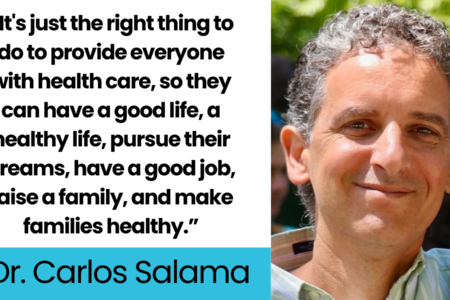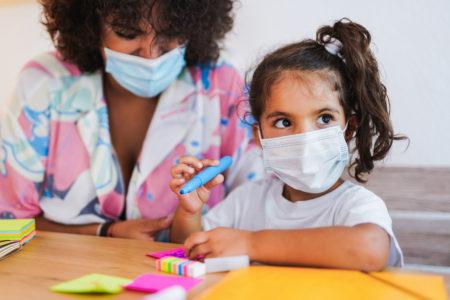
Share On Social!
We use a lot of shared devices and equipment in healthcare.
But these devices and equipment are all surfaces that can have germs on them.
Because healthcare workers use and share devices and equipment many times a day and for many different tasks, it’s important to understand the role that these devices can play in the spread of germs.
Medical Devices
Medical devices are used on a patient’s body, such as a stethoscope or blood pressure cuff.
They’re also used in a patient’s body, such as an IV needle, an endoscope, or an artificial hip.
When devices are used on or in a patient’s body to provide care, any germs on those devices can spread to places in or on the patient’s body.
That’s how devices can be the germ’s entryway into the body.
Devices that are put into a patient’s body can be a great place for germs to grow if they aren’t handled correctly because they don’t have the same protections from infection that our body tissue does.
Medical devices can also pick up germs from a patient’s body – their skin, gut, and blood – and if they aren’t handled correctly, the devices can carry those germs to other surfaces and people.
Other Shared Equipment
Healthcare workers also share other equipment that can harbor germs, such as computer keyboards and pens.
Other “high-touch” surfaces, like door handles, also have germs on them.
“We call these high-touch surfaces, and they need more frequent cleaning and disinfection because of all the hands that get on them. We know that if these germs get on our hands, then they can get all over the place, and that can make people sick,” said Dr. Abigail Carlson, an infectious diseases physician with the CDC, as part of CDC Project Firstline’s Inside Infection Control video series.
Therefore, it’s important to properly clean and disinfect shared equipment and high touch surfaces regularly.
You should also practice proper hand hygiene to prevent germs from spreading.
What Can You Do to Promote Infection Control in Your Healthcare Setting?
It is important to take infection control action to protect yourself, patients, and colleagues from germs that can spread through shared medical devices and equipment.
Remember to properly clean and disinfect objects and surfaces and maintain good hand hygiene.
How else can you stay up to date on infection control actions?
Pledge to take a training module or activity from the CDC Project Firstline!
Project Firstline creates resources, including videos and shareable images, web buttons, posters, and print materials. They also have facilitator toolkits to help workers lead trainings even if they are not an infection control expert.
Salud America! at UT Health San Antonio is working with the National Hispanic Medical Association to bring Project Firstline infection control educational content to healthcare workers, so they are equipped with the knowledge they need to protect themselves, their facilities, and their patients (Latinos and all communities) from infectious disease threats in healthcare settings.
You can read these articles:
- What is Project Firstline?
- What’s a Virus?
- How Do Viruses Make Us Sick?
- What is Ventilation and Why Does It Matter?
- What’s a Respiratory Droplet and Why Does It Matter?
- Why Do Cleaning and Disinfection Matter in Healthcare?
- We Need to Talk about Hand Hygiene Again
- What is the Goal of Infection Prevention and Control in Healthcare Settings?
- N95 Respirators: Everything You Need to Know
- How Do I Safely Use a Multi-Dose Vaccine Vial?
- Why are Gowns, Gloves, and Eye Protection Recommended for COVID-19?
“Healthcare teams in hospitals, nursing homes, and other care settings are the front lines against the spread of infection,” said Dr. Amelie G. Ramirez, director of Salud America! at UT Health San Antonio. “CDC’s Project Firstline is bolstering those efforts by developing evidence-based tools that can be delivered in a variety of ways to make infection control learning convenient and accessible for busy healthcare staff.”
Learn More about Project Firstline!
Editor’s Note: This article is part of a collaboration between Salud America!, the National Hispanic Medical Association, and the CDC’s Project Firstline. To find resources training materials, and other tools to bolster knowledge and practice of infection control, visit Project Firstline and view Salud America!’s infection control content.
Explore More:
Infection ControlBy The Numbers
142
Percent
Expected rise in Latino cancer cases in coming years




[…] The pandemic is another chapter in the bitter story of American racism and inequality. Black and Latinx people are being infected and are dying at much higher rates than white Americans. Many people of […]
[…] coronavirus has killed over 61,000 Latinos in America according to the CDC, accounting for over 18.2% of the total COVID deaths in the […]
[…] Whereas Hispanics make up 11% of D.C.’s inhabitants, they signify 19% of the COVID cases, and 14% of the deaths. Equally, 46% of D.C.’s residents are Black, they usually make up an alarming 75% […]
[…] and historical mistreatment. According to the U.S. Centers for Disease Control and Prevention, Latino and Black American communities are three times more likely to become infected with […]
[…] Covid pandemic has hit the Latino community particularly hard, and data from the nonprofit health equity advocacy group Salud America! shows Latinos lead in the 0-24 age […]
[…] the pandemic, Latinos took major blows, both in terms of COVID-19 cases and also from the economic recession under former President Donald Trump. Nearly half (49%) of […]
[…] the positive trend, the harm may have already been done. The pandemic has disproportionately impacted Latino communities. Reuters reported that election-related or political disinformation that […]
[…] pesar de la tendencia positiva, es posible que el daño ya esté hecho. La pandemia ha impactado desproporcionadamente Comunidades latinas. Reuters informó que la desinformación política o relacionada con las […]
[…] residentes blancos muestran una tasa mucho más baja con 10 muertes por cada 100,000 habitantes(8 9) . Los afroestadounidenses por su parte, denuncian subsistemas de salud que les segregan […]
[…] https://salud-america.org/coronavirus-case-rates-and-death-rates-for-latinos-in-the-united-states/ […]
[…] https://salud-america.org/coronavirus-case-rates-and-death-rates-for-latinos-in-the-united-states/ […]
[…] communities have the second-highest number of COVID-19 cases in the U.S. They’re also more likely to become hospitalized and die from the disease than other […]
[…] total, around 160,000 Latinos were killed by COVID-19. This accounts for 16% of the 1 million deaths in the country. The […]